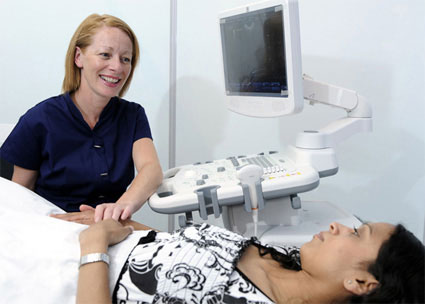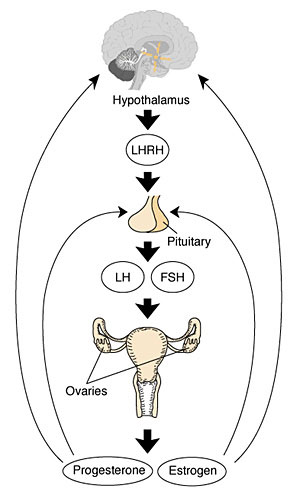In this articleWhat are tubal patency testsWhat is the role of the fallopian tubes in initiating pregnancyWhat are the causes of tubal obstructionIs it common for women to have a problem with their tubesWhat are the various tubal patency testsGas InsufflationHysterosalpingography (H.S.G.)LaparoscopyWhat are tubal patency tests Tubal patency tests are undertaken when the doctors suspect that there are blockages or pelvic adhesions in the fallopian tubes. These tests include procedures like Gas Insufflation, Hysterosalpingography (H.S.G.), Laparoscopy, etc. What is the role of the fallopian tubes in initiating pregnancy Healthy fallopian tubes are an essential pre-requisite for conception to occur. If the tubes are completely blocked, the sperm are unable to reach the egg to fertilize it. If however, the tubes are damaged and not completely blocked, the sperm may be able to reach the egg, but the early embryo is more likely to be trapped in the distorted tube - a dangerous condition known as an ectopic pregnancy. Thus it is not enough that the sperm have access to the egg. It is also necessary that the egg must not be prevented from reaching the open end of the tube. If the ovaries are surrounded by adhesions, there is a major barrier between egg and sperm. What are the causes of tubal obstruction The primary cause of tubal obstruction and pelvic adhesions is infection. Infection can be caused by peritonitis from acute appendicitis, or it may have arisen within the uterus itself as a complication of a previous termination of pregnancy, miscarriage or difficult delivery. In addition, there are a number of women who have chosen sterilization as a means of permanent birth control and change their minds for a variety of reasons. Is it common for women to have a problem with their tubes About 15% of women attending an infertility clinic will have a tubal problem. A perusal of the medical history of half of these women will show no past history of any probable cause for their damaged tubes. In such cases it is possible that a viral infection, even one caught in childhood, has been responsible for the damage. If there are no indications in your history that the tubes may be blocked, you will in all likelihood be given the benefit of the doubt initially while other causes of infertility are investigated. If, however, there is a definite past history indicating possible tubal obstruction, a test of tubal patency will be carried out at a relatively early stage. What are the various tubal patency tests 1. Gas Insufflation This is the oldest method of assessing tubal patency and is often referred to as "blowing the tubes". It is a simple test to carry out and does not require a general anaesthetic. An instrument is inserted into the canal of the cervix and carbon dioxide gas is "blown" into the cavity of the uterus. The machine controlling the flow of carbon dioxide also records the pressure of the gas as it builds up in the uterus. There will be an increase in pressure of the gas within the uterus if the tubes are blocked. If the tubes are open, the initial rise in pressure is followed by a sudden reduction as the gas escapes along the tubes and into the abdominal cavity. However, the results of this test can be difficult to interpret and the test can be unreliable. Furthermore, if the tubes are blocked, the test gives no information about the location or nature of the obstruction. The inaccuracy of the test has led it to be largely superseded by the following two procedures. 2. Hysterosalpingography (H.S.G.) A hysterosalpingogram is an X-ray of the uterus and fallopian tubes. An instrument is gently passed into the canal of the cervix and a special radio-opaque dye is carefully injected into the cavity of the uterus. The test is performed in the X-ray department and normally does not require any form of general anaesthetic. It can, however, cause you to experience a moderate amount of discomfort rather like period pains. The dye shows up on an X-ray screen and the doctor is able to see the fluid filling the uterus and then passing along both tubes to enter the cavity of the abdomen. If the dye fails to enter the tubes this may indicate an obstruction at the junction between the uterus and the tubes or simply a temporary spasm of the tubes at this site. Sometimes the dye can be seen to enter the tubes, which then become distended owing to an obstruction at their outer ends. The H.S.G. can pinpoint the site of any tubal obstruction and can also show the presence of any irregularity in the shape of the cavity of the uterus. However, this test cannot identify the existence of pelvic adhesions, which may be enveloping the ovaries and preventing eggs from having access to the tubes. 3. Laparoscopy This is a much more complex procedure than the previous two tests. It is performed under a general anaesthesia and will require your admission to hospital. A tiny incision is made at the lower border of the umbilicus. The abdominal cavity is then distended with carbon dioxide gas in order to create more space to accurately view the pelvic organs. A slim telescope called a laparoscope is then inserted into the abdominal cavity and the uterus, tubes and ovaries are thoroughly inspected. The presence of adhesions either around the tubes or tethering the ovaries can be easily detected, and their significance assessed. Other pelvic problems such as endometriosis and fibroids will also be revealed. Tubal patency is tested by injecting methylene blue dye into the uterus through the cervix. If the tubes are healthy, the dye can be seen passing along them and escaping through the outer openings of the tubes. The great advantage of laparoscopy over H.S.G. is that it allows the surgeon to have a direct view of the pelvic organs and thereby permits a much more accurate assessment of tubal patency and any tubal or ovarian problems. The need for further surgery can be determined without having to resort to major abdominal surgery at that time. The majority of patients are able to leave hospital the following day. The tiny operation scar is eventually virtually invisible.
What are tubal patency tests
Tubal patency tests are undertaken when the doctors suspect that there are blockages or pelvic adhesions in the fallopian tubes. These tests include procedures like Gas Insufflation, Hysterosalpingography (H.S.G.), Laparoscopy, etc.
What is the role of the fallopian tubes in initiating pregnancy
Healthy fallopian tubes are an essential pre-requisite for conception to occur. If the tubes are completely blocked, the sperm are unable to reach the egg to fertilize it. If however, the tubes are damaged and not completely blocked, the sperm may be able to reach the egg, but the early embryo is more likely to be trapped in the distorted tube - a dangerous condition known as an ectopic pregnancy. Thus it is not enough that the sperm have access to the egg. It is also necessary that the egg must not be prevented from reaching the open end of the tube. If the ovaries are surrounded by adhesions, there is a major barrier between egg and sperm.
What are the causes of tubal obstruction
The primary cause of tubal obstruction and pelvic adhesions is infection. Infection can be caused by peritonitis from acute appendicitis, or it may have arisen within the uterus itself as a complication of a previous termination of pregnancy, miscarriage or difficult delivery. In addition, there are a number of women who have chosen sterilization as a means of permanent birth control and change their minds for a variety of reasons.
Is it common for women to have a problem with their tubes
About 15% of women attending an infertility clinic will have a tubal problem. A perusal of the medical history of half of these women will show no past history of any probable cause for their damaged tubes. In such cases it is possible that a viral infection, even one caught in childhood, has been responsible for the damage.
If there are no indications in your history that the tubes may be blocked, you will in all likelihood be given the benefit of the doubt initially while other causes of infertility are investigated. If, however, there is a definite past history indicating possible tubal obstruction, a test of tubal patency will be carried out at a relatively early stage.
What are the various tubal patency tests
1. Gas Insufflation
This is the oldest method of assessing tubal patency and is often referred to as "blowing the tubes". It is a simple test to carry out and does not require a general anaesthetic. An instrument is inserted into the canal of the cervix and carbon dioxide gas is "blown" into the cavity of the uterus. The machine controlling the flow of carbon dioxide also records the pressure of the gas as it builds up in the uterus.
There will be an increase in pressure of the gas within the uterus if the tubes are blocked. If the tubes are open, the initial rise in pressure is followed by a sudden reduction as the gas escapes along the tubes and into the abdominal cavity.
However, the results of this test can be difficult to interpret and the test can be unreliable. Furthermore, if the tubes are blocked, the test gives no information about the location or nature of the obstruction. The inaccuracy of the test has led it to be largely superseded by the following two procedures.
2. Hysterosalpingography (H.S.G.)
A hysterosalpingogram is an X-ray of the uterus and fallopian tubes. An instrument is gently passed into the canal of the cervix and a special radio-opaque dye is carefully injected into the cavity of the uterus. The test is performed in the X-ray department and normally does not require any form of general anaesthetic. It can, however, cause you to experience a moderate amount of discomfort rather like period pains.
The dye shows up on an X-ray screen and the doctor is able to see the fluid filling the uterus and then passing along both tubes to enter the cavity of the abdomen. If the dye fails to enter the tubes this may indicate an obstruction at the junction between the uterus and the tubes or simply a temporary spasm of the tubes at this site. Sometimes the dye can be seen to enter the tubes, which then become distended owing to an obstruction at their outer ends.
The H.S.G. can pinpoint the site of any tubal obstruction and can also show the presence of any irregularity in the shape of the cavity of the uterus. However, this test cannot identify the existence of pelvic adhesions, which may be enveloping the ovaries and preventing eggs from having access to the tubes.
3. Laparoscopy
This is a much more complex procedure than the previous two tests. It is performed under a general anaesthesia and will require your admission to hospital.
A tiny incision is made at the lower border of the umbilicus. The abdominal cavity is then distended with carbon dioxide gas in order to create more space to accurately view the pelvic organs. A slim telescope called a laparoscope is then inserted into the abdominal cavity and the uterus, tubes and ovaries are thoroughly inspected.
The presence of adhesions either around the tubes or tethering the ovaries can be easily detected, and their significance assessed. Other pelvic problems such as endometriosis and fibroids will also be revealed. Tubal patency is tested by injecting methylene blue dye into the uterus through the cervix. If the tubes are healthy, the dye can be seen passing along them and escaping through the outer openings of the tubes.
The great advantage of laparoscopy over H.S.G. is that it allows the surgeon to have a direct view of the pelvic organs and thereby permits a much more accurate assessment of tubal patency and any tubal or ovarian problems. The need for further surgery can be determined without having to resort to major abdominal surgery at that time. The majority of patients are able to leave hospital the following day. The tiny operation scar is eventually virtually invisible.































